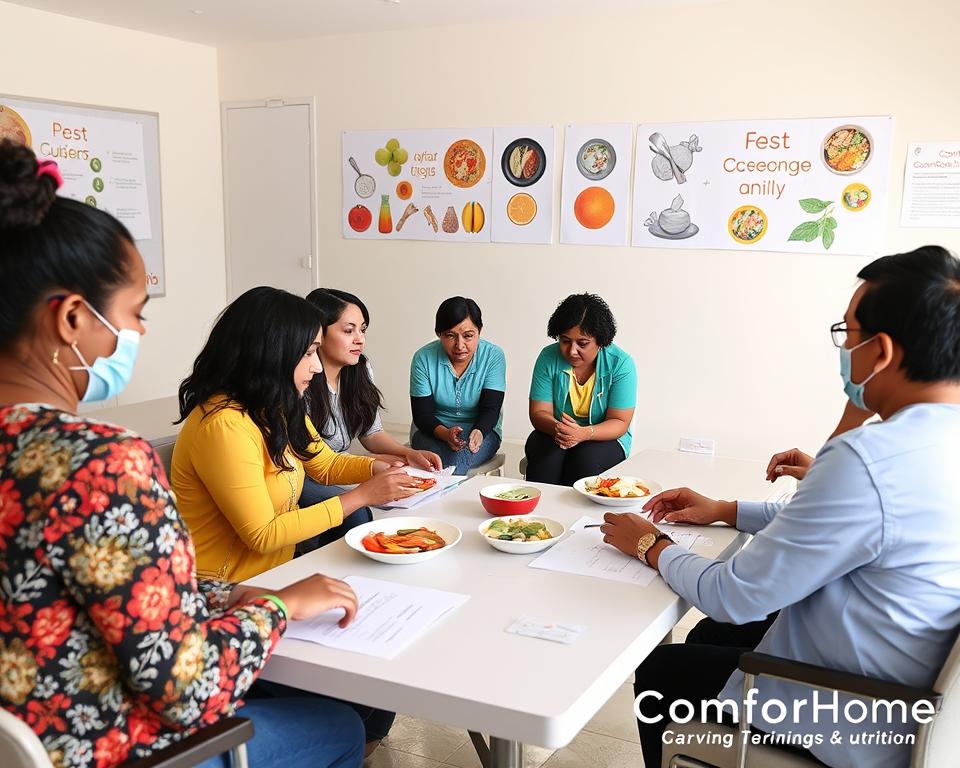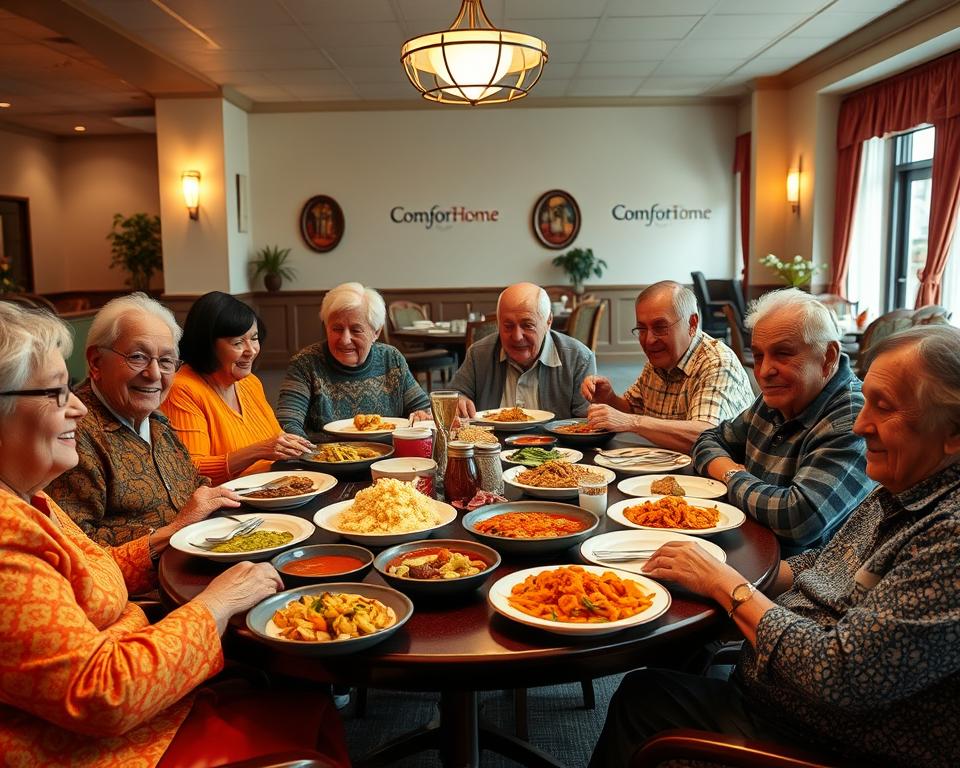Ontario’s senior population is growing fast and becoming more diverse. By 2041, 25% of Ontario’s people will be 65 or older. This is almost double the 3 million seniors in 2016 to 4.6 million. The number of visible minority seniors went up by 44% from 2011 to 2016.
This change means we need care that fits each person’s culture, especially in food. The long-term care sector has big gaps in giving care that respects language, religion, and culture. Care that includes familiar foods and cultural practices can really help seniors live better in care settings.
Key Takeaways
- Ontario’s senior population is becoming more diverse, with a significant increase in visible minority seniors.
- Culturally competent care, especially in dietary considerations, is crucial for supporting Ontario’s diverse seniors.
- The long-term care sector faces gaps in providing personalized care that respects language, religious, and cultural identities.
- Familiar foods and cultural practices can greatly improve the quality of life for seniors in care settings.
- Addressing the dietary needs of diverse seniors requires a comprehensive approach to menu planning and caregiver training.
Understanding Ontario’s Diverse Senior Population
Ontario’s senior population is getting more diverse. In 2016, 16.4% of Ontario’s people were 65 or older. By 2024, 20 percent of Canadians will be seniors, with Ontario’s seniors doubling to 4.5 million by 2041.
Most seniors (93%) live in private homes, with 63% with a partner or spouse, 23.5% alone, and 11% with relatives. Health issues vary, with 46.8% having arthritis, 48.7% high blood pressure, and 18.4% diabetes. Yet, 45.8% see their health as ‘very good’ or ‘excellent’, and 67% feel good mentally.
Ontario’s seniors are also more culturally diverse. Over 50 percent of Canada’s immigrants live in Ontario, with visible minority seniors growing fast. Toronto saw a 131 percent increase in visible minority seniors from 2006 to 2011. Seniors of Chinese and South Asian origin in Toronto grew significantly.
The growing diversity among Ontario’s seniors shows the need for culturally sensitive care. A study on homecare services highlighted the importance of language, culture, and location in caring for seniors3.
Religious and Cultural Food Restrictions in Senior Care
In Ontario, the diverse senior population has unique food needs. For example, Gyan Nath, from India, had trouble finding vegetarian food in his care home. His wife, Jyan, had to spend a lot to bring traditional food every day. Without culturally sensitive care, seniors might not get the nutrition they need, leading to isolation and more work for family caregivers.
The Long-Term Care Homes Act, 2007, and Regulation 79/10 in Ontario aim to improve care. They stress teamwork and respect among all involved4. Yet, it’s hard to meet the varied cultural and religious food needs of Ontario’s seniors.
About 9% of nursing homes in Ontario and 3% in Alberta are culturally specific. But, many facilities don’t meet the cultural needs of racialized and ethnocultural minority residents. This shows the need for better cultural understanding and practices in senior care across the province.
Dietary Considerations Across Different Cultural in Ontario Home Care
In Ontario, it’s key to meet the dietary needs of seniors from many cultures to keep them healthy. Many hospital patients and those in long-term care homes struggle with malnutrition6. Food in these places often doesn’t meet the needs of different cultures. So, it’s vital to offer food that fits each culture’s needs in home care.
The Wellesley Institute found that services tailored to each culture can really help. They lead to better health and happiness, like less depression and fewer falls. With more people not speaking English, it’s important to have food services that can communicate well with clients. Caregivers who understand and respect cultural beliefs can make care plans that work better for seniors.
But, there are not many care homes focused on culture in Ontario, and those that exist have long wait times. Malnutrition in hospitals can make stays longer. This shows how crucial it is to offer meals that fit each culture’s needs in home care. A care approach that respects culture can also make interactions better between care workers and clients7.
By focusing on multicultural meal planning and cross-cultural nutrition education for home care workers, we can help Ontario’s seniors get the food and cultural support they need to do well.
Nutritional Assessment for Multicultural Senior Care
Providing care for seniors in Ontario needs a deep understanding of different diets and preferences. Nurses must know their clients’ cultures and how their own views might affect their work. This knowledge is key for meeting the nutritional needs of Ontario’s diverse seniors.
Canada’s seniors are becoming more diverse, with 19.1% being foreign-born in 2006. With over 200,000 immigrants coming each year, it’s vital to consider their traditional foods and dietary restrictions.
A good nutritional assessment must also look at common health issues like diabetes, arthritis, and high blood pressure. Knowing how culture and health intersect helps create better care plans for seniors.
The Ontario Food and Nutrition Strategy, from 2014, has 25 actions to fight chronic disease and poor diets. It aims to improve access to healthy food, increase food literacy, and support healthier food systems. Aligning nutritional assessments with these goals helps healthcare providers meet the needs of Ontario’s multicultural seniors.
Implementing Culturally Sensitive Menu Planning
It’s key to offer meal options that fit Ontario’s diverse seniors. This means serving dishes that are familiar and traditional. For example, rice and curries can make a big difference for seniors from Indian backgrounds.
Menu planning that respects culture not only meets nutritional needs. It also keeps cultural identity strong and improves life quality for seniors in care. Healthcare groups should hire bilingual staff and use interpreters. They should also translate menu materials to meet residents’ cultural food preferences.
It’s important to know the special nutritional needs of older adults, especially in long-term care. Canada’s Food Guide is good for general advice, but it’s not specific enough for care homes. Homes in Australia and Denmark have better guidelines for their elderly populations.
Healthcare providers can meet the dietary needs of Ontario’s seniors by planning menus with cultural sensitivity. This is especially true for First Nations communities. Traditional foods are vital for their identity and connection to their lands.
Training Caregivers in Cross-Cultural Nutrition
Training caregivers in cross-cultural nutrition is key for Ontario’s diverse seniors. They need to understand different diets, religious food rules, and the importance of familiar foods. It’s also crucial to teach them about language barriers in care and nutrition.
More care workers speaking the same languages as residents can greatly improve care. This reduces stress on family members who often translate.
The LEARN model (Listen, Explain, Acknowledge, Recommend, Negotiate) helps with cross-cultural communication. Using cultural interpreters is best for medical talks with newcomer families. They provide accurate translations with cultural nuances.
But, using family or friends as translators can lead to misunderstandings. They might change information to avoid conflict. Also, apps like ‘Google Translate’ are not reliable for complex medical talks14.

The role of cultural competence in nutrition is vital. Poor communication can cause serious issues, like misdiagnosis or lower treatment follow-through. By focusing on caregiver education, healthcare can offer better care to Ontario’s seniors.
Building Inclusive Food Service Programs
Creating inclusive meal services is key for Ontario’s seniors. These programs need to offer a variety of *culturally diverse menus*. This way, they can meet different dietary needs and preferences. For instance, adding vegetarian options for seniors like Gyan Nath, who faced a limited menu in his care home.
Food service programs should also celebrate religious and cultural events with special meals. This not only ensures seniors get the nutrition they need but also keeps their cultural ties strong. It improves their quality of life in care settings.
Many groups, including consumers and Indigenous partners, were consulted for these programs. They agreed that food security means having access to safe, affordable, *culturally appropriate food*. This should be part of a fair and sustainable food system.
Financial issues, like high housing costs, were seen as major causes of food insecurity. Better food retail options, a healthy agricultural sector, and more land for food production were suggested to improve community food security.
Experts recommended working together across sectors and having stable funding for these initiatives. They also suggested better transportation for food access and clearer ways to measure food security efforts15. Budget 2019 announced over $134 million to support Canada’s food policy.
Connecting with Cultural Food Resources in Ontario
It’s key to connect with cultural food resources in Ontario for seniors in care. This means working with cultural food suppliers, community organizations, and ethnic food markets. They help get authentic ingredients and meals. Also, talking to cultural groups gives insights into cooking and meal likes.
Using these resources, care providers can offer more food choices. This makes meals better and seniors happier in Ontario’s care homes. A study showed that strong social ties can help with food issues from racism. This is why linking up with community food programs is vital for keeping cultural food traditions alive, especially for Indigenous elders.
The Canadian diet often lacks healthy foods and has too much processed stuff. So, care providers need to find better cultural food suppliers and community food programs. This move towards healthier diets in Ontario is important for seniors to get the care and food they need





